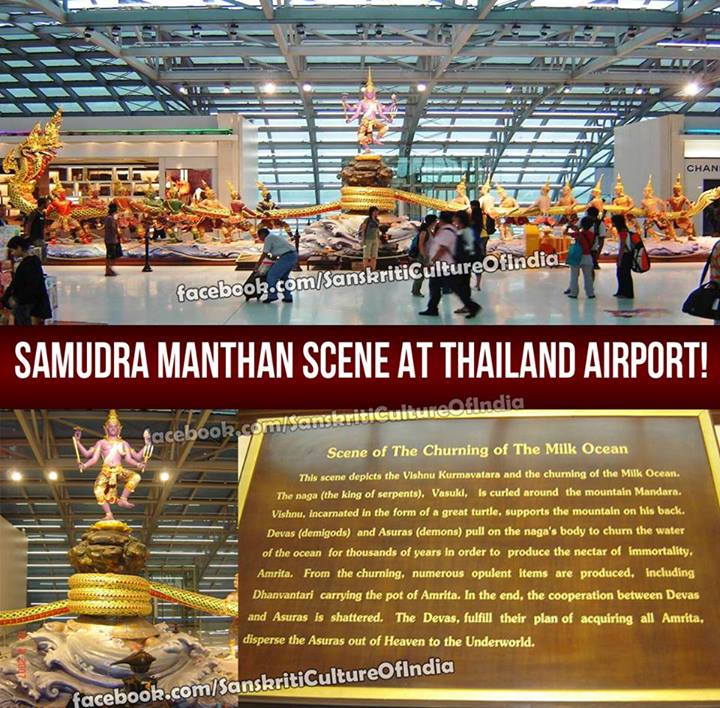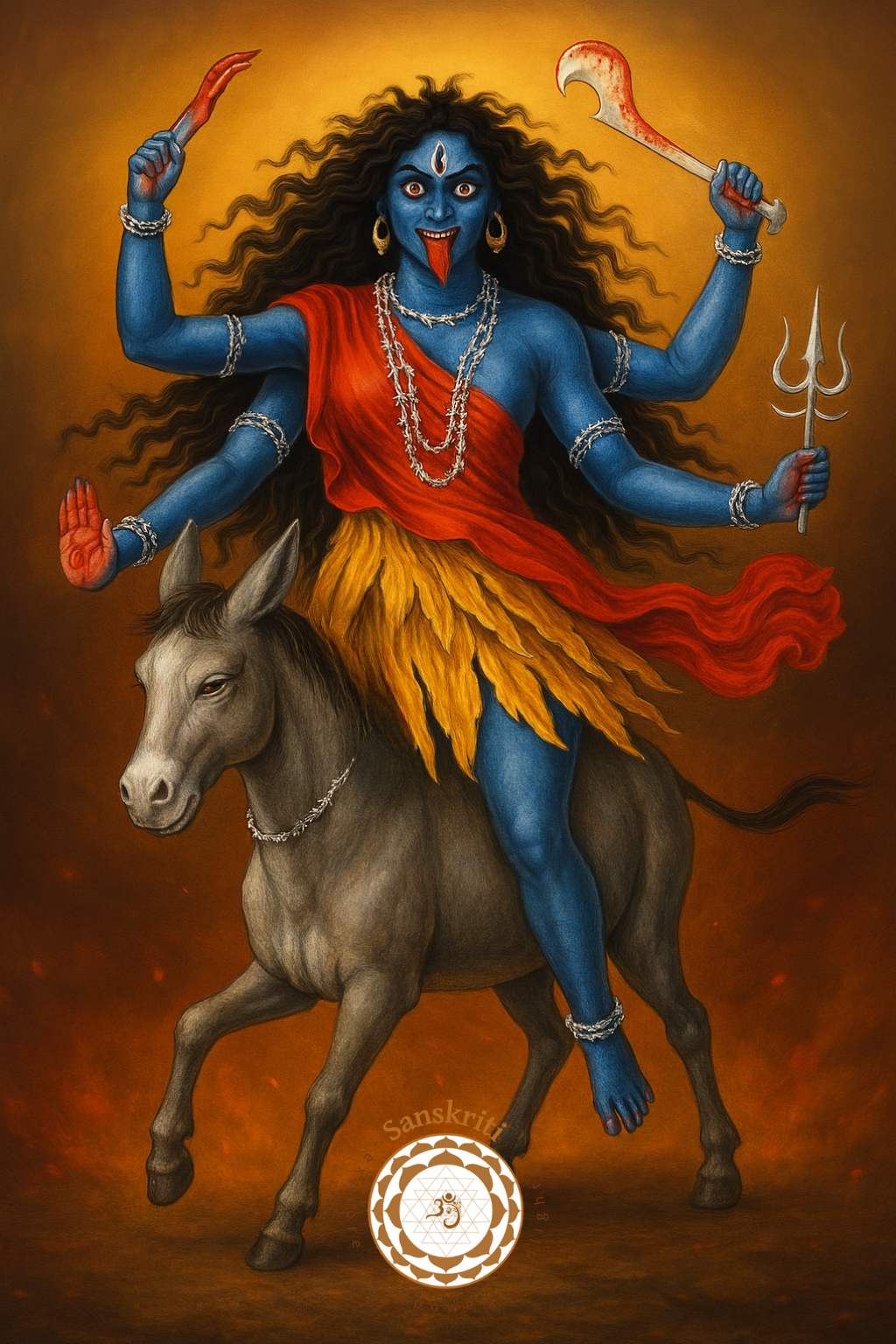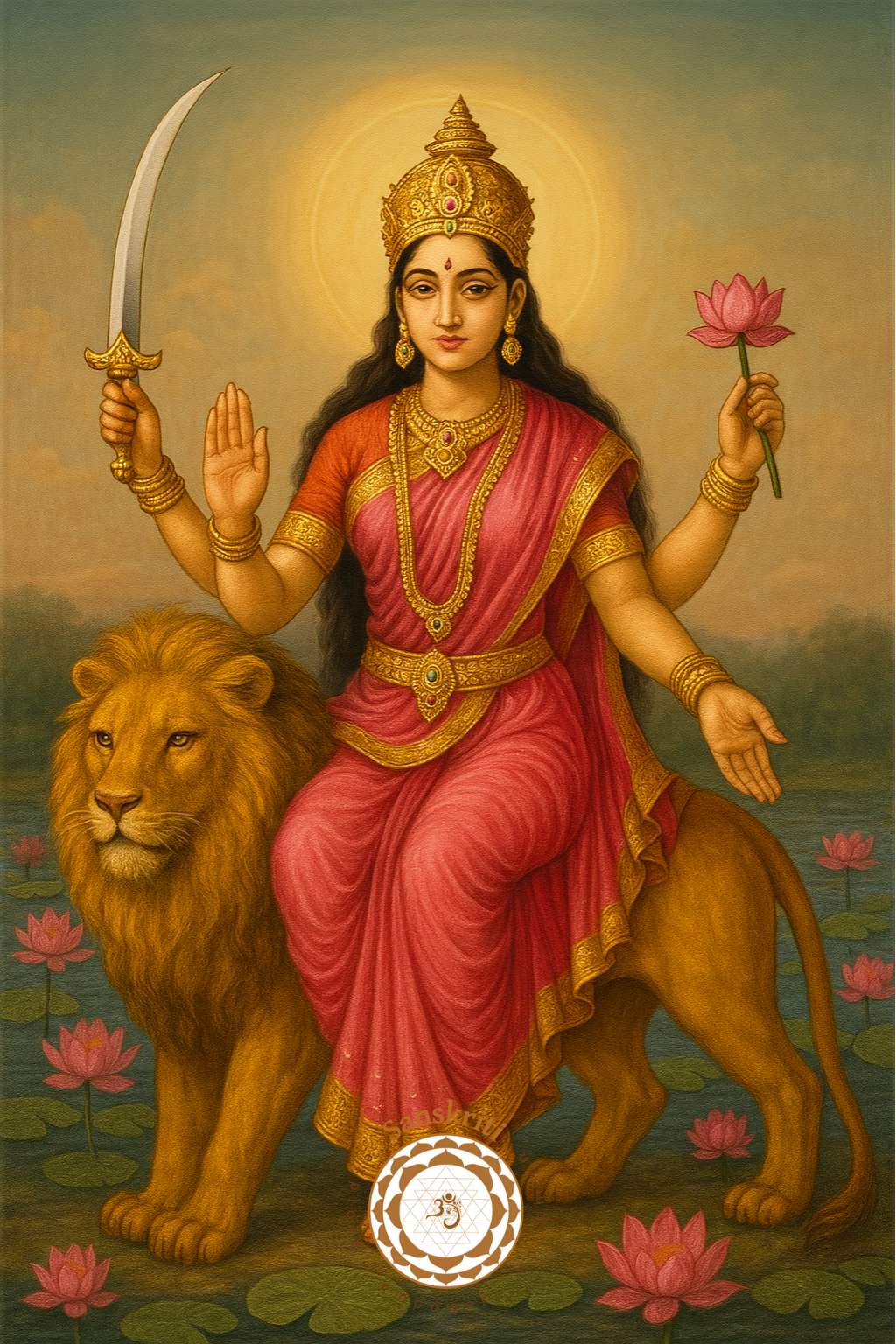Srimad Bhagavatam sketches an detailed account of how many millions of years ago in the heavenly planets of this universe, a fierce battle for supremacy raged between the Devas (demigods) and the Asuras (demons). Devas Represent ‘Good’, and Asuras represent ‘Evil’. Samudra Manthan literally means: The Churning of the Ocean.
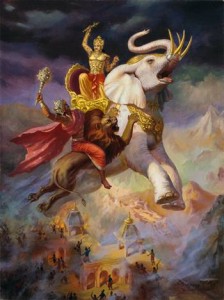 Legend Behind Samudra Manthan:
Legend Behind Samudra Manthan:
Indra the King of Gods, while riding on an elephant one day came across Durvasa Muni who offered him a special garland. Indra accepted the garland but put it on the trunk of the elephant. The elephant was irritated by the smell and it threw the garland on the floor. This enraged the sage as the garland was a dwelling of Sri (fortune) and was to be treated as prasada. Durvasa Muni cursed Indra and all Devas to become poverty-stricken and bereft of all influence and strength, their lives loose all auspiciousness. In due course of time they were defeated by the asuras, as the result of the curse. The devas then appealed to Lord Vishnu for help. Lord Vishnu suggested them to make a truce with the demons in a diplomatic manner so that they can work together towards the Ksheera Sagara Mathan, or the churning of the ocean of milk, to produce the nectar of immortality. Lord Vishnu told Devas that he would arrange that the devas alone obtain the nectar.
The Churning of the Ocean:
Following the instructions of Lord Vishnu, the demigods approached the leaders of the demons, and an agreement was reached, after which they all left for the ocean of milk to start the churning. The Samudra manthan started with Asuras who were under the leadership of the mighty Bali Maharaja, a descendant of the great demoniac king Hiranyakashapu and Devas under the leadership of Lord Indra.
The churning of the ocean was an elaborate process. Lord Vishnu helped them by carrying Mandara Mountain on the back of Garuda, His vahana which was used as churning rod and Vasuki, the King of Serpents, became the churning rope. The demons insisted that they should hold the front part of the snake during the churning, while the devas, on the encouragement of Lord Vishnu held its tail. As they began pulling the “rope” to produce nectar, smoke and blazing fire emanated from Vasuki’s many mouths, causing great suffering for the Asuras. As the demons and demigods continued churning, the huge Mandara Mountain began sinking into the ocean of milk because it was without support. The Lord then took the form of a Kurma-avatara, tortoise, entered the ocean, and held the mountain on His back to allow the churning to continue. Lord Vishnu himself had to intercede in so many ways to aid the Devas. All kinds of herbs were cast into the ocean and many great beings and objects were produced from the ocean and were divided between asuras and gods. It is said that following things emerged from the Samudra Manthan.
During the churning of the ocean it first produced a poison called halahala that spread in all directions. This terrified the Gods and demons as the poison was so toxic that it effects would have wiped out the entire creation. On the advice of Lord Vishnu, Gods approached Lord Shiva for help and protection as only he could swallow it without being affected. On the request of gods and out of compassion for living beings, Lord Shiva gathered the poison in his palms and drank it. However, Parvati Lord Shiva’s consort pressed his neck so that the poison does not reach his stomach. Thus, it stayed in his throat neither going up nor going down and Shiva remained unharmed. The poison was so potent that it changed the color of Lord Mahadeva’s neck to blue. For this reason, Lord Shiva is also called Neelakantha (the blue-necked one) where ‘Neela’ means blue and ‘Kantha’ means neck or throat.
Fourteen different ratnas (gems) were also recovered during this pastime of churning, and these were mostly kept by the demigods, although the asuras tried to cheat them out of the treasures. All kinds of herbs were cast into the ocean to produce these fourteen ratnas, which were divided between the asuras and demigods, as follows:
- Lakshmi, the Goddess of Fortune and Wealth
- Kaustubha, the most valuable jewel in the world
- Parijata, the divine flowering tree
- Varuni, goddess and creator of intoxicating beverages
- Dhanvantari, the doctor
- Chandra, the moon
- Kamadhenu, the wish-granting divine cow
- Kalpavriksha, the wish-granting tree
- Airavata, the elephant of Indra
- Apsaras, various divine nymphs like Rambha, Menaka, Punjikasthala, etc.
- Uchhaishravas, the divine 7-headed horse
- Sharanga, the bow of Vishnu
- Shankha, Vishnu’s conch
- Amrita, the nectar of immortality.
The ocean also produced Balacandra, the crescent moon. Because of its cooling effect, Balacandra was offered to Lord Siva to wear on his head, finally Dhanvantari appeared with the Kumbha filled with nectar. Seeing Dhanvantari holding the jug of nectar, their most cherished object, they all lost self-control and patience. The demons immediately snatched the pot away by force, and a fight ensued.
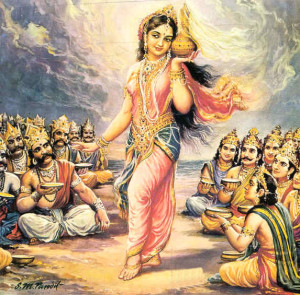 Over a period of twelve days of fighting, some of the nectar was spilled, and it fell on four places on earth: Nasik, in Maharashtra; Ujjain, in Madhya Pradesh; and Haridwar and Allahabad, in Uttar Pradesh. The asuras finally defeated the devas and carried off the pot of nectar, leaving the devas morose. Soon after, the demons began quarreling among themselves over who would get to drink the nectar first. While they were fighting, Lord Vishnu assumed the form of an extremely beautiful woman, known as Mohini and enchants the demons with her beauty. The demons, completely overwhelmed by Her charm, asked Her to serve as an arbitrator. She accepted the position on the condition that no one would oppose Her or protest against whatever She would do or say. The asuras agreed and handed the amta-kumbha over to Her, requesting Her to distribute it.
Over a period of twelve days of fighting, some of the nectar was spilled, and it fell on four places on earth: Nasik, in Maharashtra; Ujjain, in Madhya Pradesh; and Haridwar and Allahabad, in Uttar Pradesh. The asuras finally defeated the devas and carried off the pot of nectar, leaving the devas morose. Soon after, the demons began quarreling among themselves over who would get to drink the nectar first. While they were fighting, Lord Vishnu assumed the form of an extremely beautiful woman, known as Mohini and enchants the demons with her beauty. The demons, completely overwhelmed by Her charm, asked Her to serve as an arbitrator. She accepted the position on the condition that no one would oppose Her or protest against whatever She would do or say. The asuras agreed and handed the amta-kumbha over to Her, requesting Her to distribute it.
Mohini made the devas and asuras sit in separate lines, and She delivered the nectar to the devas while speaking sweet words to the demons. A daitya named Rahu was watching all these leela and was intelligent to suspect some foul play in this distribution. He suddenly realized the trick that Mohini was playing with the demons. He immediately transformed himself into a figure of like-god and queued up in the line with gods before the gods could realize it. He sat in between two deities Surya Dev (Sun God) and Chandra Dev (Moon God) who was sitting at the end of the last row. Chandra dev immediately recognized him and signaled Mohini to avoid Rahu who was in disguise of god sitting next to him as Mohini was about to serve it to Rahu and coming for Chandra dev at the last. But it was too late before Mohini could realize. Rahu had already had his share and gulped it down his throat.
Immediately Shri Vishnu reappeared in His original Form from emerging out of His Mohini incarnation. Serving the remaining portion of the ambrosia to Chandra Dev (Moon) he threw the pot on the Earth and sprang into action to catch up Rahu.
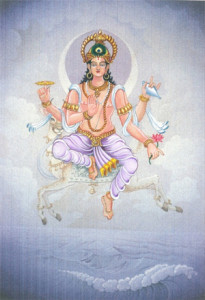 Rahu, understood Her trick. He dressed himself like a demigod, sat down in the line of the demigods, and received the nectar. The sun and moon detected him and disclosed his identity to Mohini, who immediately took up Her disc, which is razor-sharp, and severed his head before he could swallow the immortal beverage. Although his body from the neck down died, his head remained alive because of the nectar in his mouth. In order to save his own life Rahu tried to run away from the scene as fast as he could. But Shri Vishnu’s Sudarshan Chakra (the discus) was released to server his head from his body. Since Rahu had already drunk the ambrosia he did not die. Chandra dev witnessing all these events pleaded Lord Vishnu to spare him and said, “O, my Lord, please do not asunder his body into any more pieces, as each piece falling on ground would incarnate as daityas and they will multiply again to trouble the gods in turn”.
Rahu, understood Her trick. He dressed himself like a demigod, sat down in the line of the demigods, and received the nectar. The sun and moon detected him and disclosed his identity to Mohini, who immediately took up Her disc, which is razor-sharp, and severed his head before he could swallow the immortal beverage. Although his body from the neck down died, his head remained alive because of the nectar in his mouth. In order to save his own life Rahu tried to run away from the scene as fast as he could. But Shri Vishnu’s Sudarshan Chakra (the discus) was released to server his head from his body. Since Rahu had already drunk the ambrosia he did not die. Chandra dev witnessing all these events pleaded Lord Vishnu to spare him and said, “O, my Lord, please do not asunder his body into any more pieces, as each piece falling on ground would incarnate as daityas and they will multiply again to trouble the gods in turn”.
Hearing these pleadings of Moon, Lord Vishnu realized and thus spared him as He spoke to Rahu, “Since you have drunk the nectar sitting amongst the gods now you must leave your asura life style. You must now stay with Surya (Sun) and Chandra (Moon) and other seven planets forever to be now counted amongst nine planets (Navagraha)”. Thus the severed head of the Asura is called as Rahu while the body without the head is called as Ketu.

